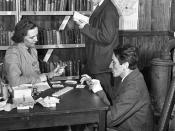The Quebec Bridge Collapse
The Quebec Bridge took twenty years of planning and construction before it was open to the public in 1917. Fifteen seconds later the bridge collapsed into the St. Lawrence River. The reason for this disaster can be found in the years before in the design and a prior failure.
The desire to build a bridge over the St. Lawrence River was fueled by Quebec's need to be competitive in trade. The Phoenix Bridge Company started the design of a cantilever superstructure in 1897, when the consulting engineer Theodore Cooper arrived at the site of the bridge. Cooper, who was one of the best bridge builders of his day, approved the company's plans. The only change Cooper would recommend was to lengthen the span of the bridge from sixteen hundred feet to eighteen hundred feet making it the largest bridge at the time. He accepted the estimates of weight that the bridge company provided.
Cooper was criticized by Robert Douglas after he reviewed Coopers' new additions for the bridge stating that it had high unit stresses. Later Cooper appointed an inexperienced, newly graduated engineer to help supervise the construction of the bridge. Work continued and on August 27 the bridge collapsed. There were eighty-six men working on the bridge only eleven survived. The investigative report, conducted by the members of the Royal Commission of Inquiry, stated "We are satisfied that no one connected with the work was expecting immediate disaster, and we believe that in the case of Mr. Copper his opinion was justified. He understood that erection was not proceeding; and without additional load the bridge might have held out for days."
After the collapse, the government took over the design and construction of the new bridge. This also provided the financial support for the...


